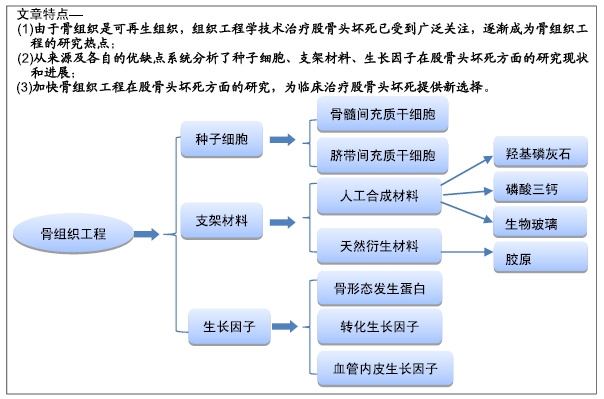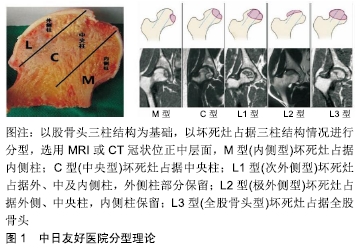[1] 张长青.股骨头坏死保髋治疗指南(2016版)[J].中华老年骨科与康复电子杂志, 2016, 2(2):65-70.
[2] CUI L, ZHUANG Q, LIN J, et al. Multicentric epidemiologic study on six thousand three hundred and ninety five cases of femoral head osteonecrosis in China. Int Orthop. 2016;40(2): 267-276.
[3] ZHAO DW, YU M, HU K, et al. Prevalence of Nontraumatic Osteonecrosis of the Femoral Head and its Associated Risk Factors in the Chinese Population: Results from a Nationally Representative Survey. Chin Med J (Engl). 2015;128(21): 2843-2850.
[4] 李子荣.2015年股骨头坏死中国分期与分型解读[J].临床外科杂志,2017,25(8):565-568.
[5] 李子荣.股骨头坏死临床诊疗规范[J].中国矫形外科杂志,2016, 24(1):49-54.
[6] HANG D, WANG Q, GUO C, et al. Treatment of osteonecrosis of the femoral head with VEGF165 transgenic bone marrow mesenchymal stem cells in mongrel dogs. Cells Tissues Organs. 2012;195(6):495-506.
[7] 杭栋华,阎作勤,郭常安,等.VEGF-165基因修饰的骨髓间充质干细胞移植修复犬股骨头坏死[J].复旦学报(医学版),2007,34(6): 806-811.
[8] 王亚寒. hCGRP α基因修饰BMSCs联合自体骨移植治疗股骨头坏死的实验研究[D].郑州:郑州大学,2012.
[9] 张波,韦冰丹,甘坤宁,等.富血小板血浆联合骨髓间充质干细胞对兔股骨头坏死BMP-2/Smads通路的影响[J].中国骨质疏松杂志, 2016,22(2):131-134.
[10] 袁林,钱钧,杨征毅,等.不同来源骨髓间充质干细胞成骨能力的比较[J].口腔疾病防治,2017,25(9):554-559.
[11] 侯克东,卢世璧,张莉,等.人脐带Wharton胶中间充质干细胞的分离、培养与鉴定[J].解放军医学杂志,2008,33(4):375-378.
[12] 吕璐璐,宋永平,魏旭东,等.人脐带和骨髓源间充质干细胞生物学特征的对比研究[J].中国实验血液学杂志,2008,16(1): 140-146.
[13] YE B, LUO X, LI Z, et al. Rapid biomimetic mineralization of collagen fibrils and combining with human umbilical cord mesenchymal stem cells for bone defects healing. Mater Sci Eng C Mater Biol Appl. 2016;68:43-51.
[14] 高宏阳,刘新晖,李晓明,等.脐带间充质干细胞与纳米仿生骨材料联合治疗早期股骨头缺血坏死的中期疗效观察[J].生物骨科材料与临床研究,2016,13(4):18-21.
[15] 吴若丹,白云鹤,姚鹏举,等.放射介入技术加脐带间充质干细胞治疗成年人股骨头缺血性坏死18例临床研究[J].中国实用医药, 2012,7(10):73-74.
[16] 潘倩雯,刘宏,李力.纳米羟基磷灰石复合材料人工骨的研究进展[J].中国药房,2017,28(4):566-569.
[17] 胡庆柳.仿松质骨的胶原/纳米羟基磷灰石人工骨治疗免股骨头坏死的动物实验[J].中国组织工程研究与临床康复,2009,13(21): 4093-4097.
[18] 徐鸿尧,赵建宁,郭亭.纳米羟基磷灰石/聚酰胺66骨支撑材料与钽棒置入修复早期股骨头坏死:近期效果比较[J].中国组织工程研究,2014,18(39):6292-6297.
[19] SHUAI C, GAO C, FENG P, et al. Grain growth associates mechanical properties in nano-hydroxyapatite bone scaffolds. J Nanosci Nanotechnol.2013;13(8):5340-5345.
[20] YANG P, BIAN C, HUANG X, et al. Core decompression in combination with nano-hydroxyapatite/polyamide 66 rod for the treatment of osteonecrosis of the femoral head. Arch Orthop Trauma Surg. 2014;134(1):103-112.
[21] 孙伟,李子荣,史振才,等.纳米晶胶原基骨和骨髓间充质干细胞复合修复兔股骨头坏死缺损的研究[J].中国修复重建外科杂志, 2005,19(9):703-706.
[22] STILLER M, KLUK E, BOHNER M, et al. Performance of β-tricalcium phosphate granules and putty, bone grafting materials after bilateral sinus floor augmentation in humans. Biomaterials. 2014;35(10):3154-3163.
[23] MANCHÓN A, ALKHRAISAT M, RUEDA-RODRIGUEZ C, et al. Silicon calcium phosphate ceramic as novel biomaterial to simulate the bone regenerative properties of autologous bone. J Biomed Mater Res A. 2015;103(2):479-488.
[24] TAKAHASHI Y, YAMAMOTO M, TABATA Y. Osteogenic differentiation of mesenchymal stem cells in biodegradable sponges composed of gelatin and beta-tricalcium phosphate. Biomaterials. 2005;26(17):3587-3596.
[25] 孙伟,李子荣,高福强,等.磷酸三钙多孔生物陶瓷修复股骨头坏死[J].中国组织工程研究,2014,18(16):2474-2479.
[26] DUAN R, BARBIERI D, LUO X, et al. Submicron-surface structured tricalcium phosphate ceramic enhances the bone regeneration in canine spine environment.J Orthop Res.2016; 34(11):1865-1873.
[27] 李云矗,孙平,徐刚,等.磷酸三钙陶瓷棒结合骨髓间充干细胞治疗股骨头坏死近期疗效[J].牡丹江医学院学报,2016,37(6):7-10.
[28] CIVININI R, DE BIASE P, CARULLI C, et al. The use of an injectable calcium sulphate/calcium phosphate bioceramic in the treatment of osteonecrosis of the femoral head. Int Orthop. 2012;36(8):1583-1588.
[29] CHIBA S, ANADA T, SUZUKI K, et al. Effect of resorption rate and osteoconductivity of biodegradable calcium phosphate materials on the acquisition of natural bone strength in the repaired bone. J Biomed Mater Res A. 2016;104(11): 2833-2842.
[30] KRUSE A, JUNG RE, NICHOLLS F, et al. Bone regeneration in the presence of a synthetic hydroxyapatite/silica oxide-based and a xenogenic hydroxyapatite-based bone substitute material. Clin Oral Implants Res. 2011;22(5):506-511.
[31] ZERBO IR, ZIJDERVELD SA, DE BOER A, et al. Histomorphometry of human sinus floor augmentation using a porous beta-tricalcium phosphate: a prospective study. Clin Oral Implants Res. 2004;15(6):724-732.
[32] 彭晨健,杜斌,孙光权,等.3D打印β-磷酸三钙支架复合淫羊藿苷微粒修复兔股骨头坏死[J].中国组织工程研究,2019,23(14): 2162-2168.
[33] LIN S, CUI L, CHEN G, et al. PLGA/β-TCP composite scaffold incorporating salvianolic acid B promotes bone fusion by angiogenesis and osteogenesis in a rat spinal fusion model. Biomaterials. 2019;196:109-121.
[34] LAI Y, CAO H, WANG X, et al. Porous composite scaffold incorporating osteogenic phytomolecule icariin for promoting skeletal regeneration in challenging osteonecrotic bone in rabbits. Biomaterials. 2018;153:1-13.
[35] XYNOS ID, EDGAR AJ, BUTTERY LD, et al. Ionic products of bioactive glass dissolution increase proliferation of human osteoblasts and induce insulin-like growth factor II mRNA expression and protein synthesis. Biochem Biophys Res Commun. 2000;276(2):461-465.
[36] XYNOS ID, EDGAR AJ, BUTTERY LD, et al. Gene-expression profiling of human osteoblasts following treatment with the ionic products of Bioglass 45S5 dissolution. J Biomed Mater Res. 2001;55(2):151-157.
[37] LEACH JK, KAIGLER D, WANG Z, et al. Coating of VEGF-releasing scaffolds with bioactive glass for angiogenesis and bone regeneration. Biomaterials. 2006; 27(17):3249-3255.
[38] HUANG W, DAY DE, KITTIRATANAPIBOON K, et al. Kinetics and mechanisms of the conversion of silicate (45S5), borate, and borosilicate glasses to hydroxyapatite in dilute phosphate solutions. J Mater Sci Mater Med. 2006;17(7):583-596.
[39] 崔旭,李乐,顾刈非,等.硼酸盐生物玻璃支架的制备与性能[J].生物骨科材料与临床研究, 2013,10(3):6-10.
[40] 程中华,薛威,王李琴,等.骨髓间充质干细胞结合硼硅酸盐玻璃支架修复兔股骨头坏死[J].骨科,2017,8(2):121-126.
[41] 马超,张丁,李平,等.成骨细胞在两种胶原支架材料上的生长特征[J].中国医学科学院学报,2011,33(5):538-542,593.
[42] 孙开瑜,徐铭恩,周永勇.基于3D打印的Ⅰ型胶原涂覆β-TCP骨组织工程支架研究[J].中国生物医学工程学报,2018,37(3): 335-343.
[43] 沈铁城,黄永辉,徐晓峰,等.纳米晶胶原基骨材料在临床上的应用[J].医学研究杂志,2006,35(4):70-73.
[44] LAMPLOT JD, QIN J, NAN G, et al. BMP9 signaling in stem cell differentiation and osteogenesis. Am J Stem Cells. 2013; 2(1):1-21.
[45] PAN ZX, ZHANG HX, WANG YX, et al. Effect of recombinant human bone morphogenetic protein 2/poly-lactide-co-glycolic acid (rhBMP-2/PLGA) with core decompression on repair of rabbit femoral head necrosis. Asian Pac J Trop Med. 2014; 7(11):895-899.
[46] 李子荣,孙伟,史振才,等.加入和未加骨形态发生蛋白2的打压植骨术治疗股骨头坏死[J].中国骨与关节外科,2012,5(5):377-381.
[47] 陈镇秋,何伟,魏秋实,等.激素性股骨头坏死患者骨组织中骨代谢相关因子的表达[J].中华关节外科杂志(电子版),2015,9(2): 183-188.
[48] DEVESCOVI V, LEONARDI E, CIAPETTI G, et al. Growth factors in bone repair. Chir Organi Mov. 2008;92(3):161-168.
[49] 沈颉.血管内皮生长因子(VEGF)在血管外膜成纤维细胞的表达研究[J].当代医学,2012,18(24):24-26.
[50] 王维军,李嗣生,牛东生,等.股骨头缺血性坏死骨质含量与VEGF、bFGF、BMP-2 mRNA表达的相关性研究[J].中国修复重建外科杂志, 2011,25(8):984-991.
[51] 周勇,任菲菲,丰凡翔,等.血管内皮生长因子和骨形态发生蛋白2在非创伤性股骨头坏死不同区域的表达[J].中医正骨,2015, 27(8):7-10.
[52] ZHANG C, MA J, LI M, et al. Repair effect of coexpression of the hVEGF and hBMP genes via an adeno-associated virus vector in a rabbit model of early steroid-induced avascular necrosis of the femoral head. Transl Res. 2015;166(3): 269-280.
[53] 王蕾,彭吾训,张爱华,等.双相陶瓷生物骨-骨形态发生蛋白-碱性成纤维细胞生长因子复合物修复股骨头坏死模型的实验研究[J].中国康复理论与实践, 2013,19(5):426-431.
|


